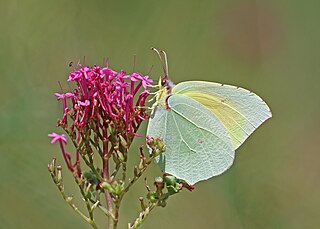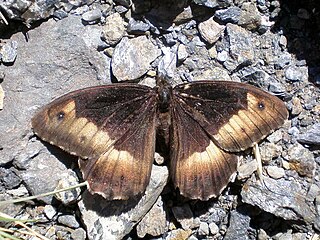Contents
| Minois dryas | |
|---|---|
 | |
| Upperside | |
 | |
| Underside | |
| Scientific classification | |
| Kingdom: | |
| Phylum: | |
| Class: | |
| Order: | |
| Family: | |
| Genus: | |
| Species: | M. dryas |
| Binomial name | |
| Minois dryas | |
Minois dryas, the dryad, is a butterfly of the family Nymphalidae.
| Minois dryas | |
|---|---|
 | |
| Upperside | |
 | |
| Underside | |
| Scientific classification | |
| Kingdom: | |
| Phylum: | |
| Class: | |
| Order: | |
| Family: | |
| Genus: | |
| Species: | M. dryas |
| Binomial name | |
| Minois dryas | |
Minois dryas, the dryad, is a butterfly of the family Nymphalidae.
Subspecies include: [1]
This species can be found in southern and central Europe up to central Asia and Japan. [3] [1] It prefers margins of mixed woodland and sunny grasslands with plenty of flowers, at an elevation of 100–1,600 metres (330–5,250 ft) above sea level. [4] [5]
The wingspan is 54–70 millimetres (2.1–2.8 in). [4] The basic color of the upperside of the wings is dark brown. The females are larger and paler than the males. On each forewing there are two large eyelets with bluish pupils, while in each hindwing there is just a small eyelet. The underside of the wings is quite similar, but the eyelets on the forewings show a yellowish border and the hindwings are mainly gray brown. [5]
This species is rather similar to Satyrus actaea and Satyrus ferula . In the last one the forewing eyespots centered with white. [5]
The butterfly is on wing from June to September [4] depending on the location. They usually feed on nectar of scabious ( Scabiosa species), hemp agrimony ( Eupatorium cannabinum ) and other tall flowers. [5] The larvae feed on grass species, such as Molinia caerulea , Arrhenatherum elatius , Oryza sativa , Avena , Dactylis , Poa , Festuca , Carex , Calamagrostis and Bromus species. [1]

The large skipper is a butterfly of the family Hesperiidae.

Melanargia galathea, the marbled white, is a medium-sized butterfly in the family Nymphalidae. Despite its common name and appearance, this butterfly is one of the "browns", of the subfamily Satyrinae.

Aporia crataegi, the black-veined white, is a large butterfly of the family Pieridae. A. crataegi is widespread and common. Its range extends from northwest Africa in the west to Transcaucasia and across the Palearctic to Siberia and Japan in the east. In the south, it is found in Turkey, Cyprus, Israel, Lebanon and Syria. It is not usually present in the British Isles or northern Scandinavia.

Cyaniris semiargus, the Mazarine blue, is a Palearctic butterfly in the family Lycaenidae.

The purple-shot copper is a butterfly in the family of the Lycaenidae or copper butterflies and in the genus of the Lycaena.

Lampides boeticus, the pea blue, or long-tailed blue, is a small butterfly that belongs to the lycaenids or gossamer-winged family.

Melitaea diamina, the false heath fritillary, is a butterfly of the family Nymphalidae.

The scarce copper is a butterfly of the family Lycaenidae.

The purple-edged copper is a butterfly of the family Lycaenidae.

Satyrium spini, the blue spot hairstreak, is a butterfly in the family Lycaenidae.

Erebia euryale, the large ringlet, is a species of butterfly belonging to the family Nymphalidae.

Colias palaeno, known by the common names moorland clouded yellow, palaeno sulphur, and pale Arctic clouded yellow, is a butterfly in the family Pieridae.

Gonepteryx cleopatra, the Cleopatra or Cleopatra butterfly, is a medium-sized butterfly of the family Pieridae.

The marbled ringlet is a member of the subfamily Satyrinae of the family Nymphalidae.

Hipparchia fagi, the woodland grayling, is a butterfly of the family Nymphalidae.

Melitaea didyma, the spotted fritillary or red-band fritillary, is a Palearctic butterfly of the family Nymphalidae.

Glaucopsyche alexis, the green-underside blue, is a butterfly of the family Lycaenidae. It is found in the Palearctic.

Plebejus argyrognomon, common name Reverdin's blue is a butterfly of the family Lycaenidae. The species is named after Jacques-Louis Reverdin.

Polyommatus amandus, the Amanda's blue, is a butterfly of the family Lycaenidae. It is found in the Palearctic realm.

Satyrus ferula, the great sooty satyr, is a butterfly of the family Nymphalidae.